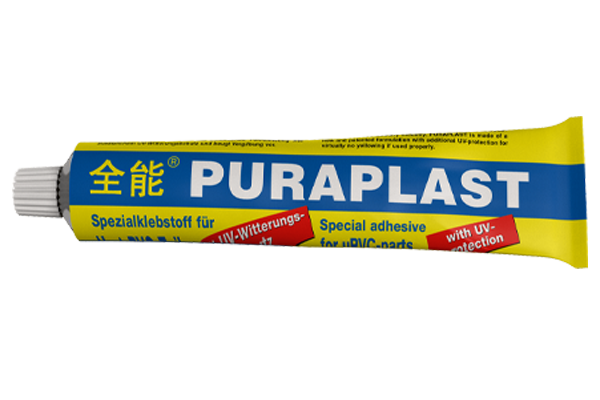PURAPLAST 200G
KEY SPECIFICATIONS
High performance 1C Adhesive for PVC Window Corner Repair.
Inhalt: 200g aluminium tube.
Chemical Basis: Vinyl Chloride Polymers, Dissolved From.

- High performance one-component sealant
- Expanding welding agent based on vinyl chloride polymers
- Patented formulation with additional UV-protection
- Extraordinary resistant to yellowing effect
- Good resistant to water, alcohol, oil, gasoline
- Easy application on jobsite
- Quick curing by solvent welding system
- Designed for bonding and repair of uPVC profiles in window construction
- Re-usable
- Bonding and repair of uPVC profiles in window construction and sanitary industry
- Repair of uPVC corner connections on job site
- Bonding of profile material such as runoff slats, striking slats, weather bars, rolling blind parts, etc.
- Suitable for bonding of ABS (pipes, plates, injection moulded parts, etc.)
- NOT suitable for PMMA and acrylic surfaces (decorative profiles)
| FEATURE | TECHNICAL VALUE | INSPECTION CONDITIONS |
| Chemical basis | Vinyl chloride polymers, dissolved form | |
| Colour | White | |
| UV resistant | According to Xenon test | DIN 5337 |
| Consistency | Thixotropic | 23°C, 50% RAH |
| Operation stability | ~2 to 4 minutes | 23°C, 50% RAH |
| Curing time | ~24 hours | 23°C, 50% RAH |
| Density | ~0,98 kg/l | |
| Temperature resistance | -25°C up to +90°C | |
| Hazardous material class | A1 as per VbF | |
| Processing temperature | +5°C up to +35°C | |
| Shelf life | 24 months | 23°C, 50% RAH |
| Packaging | 200 g aluminum tube / 20 pcs./box |
| MATERIAL | EIGNUNG |
| Aluminium | not suitable |
| Beton | not suitable |
| Chrom | not suitable |
| Dachziegel | not suitable |
| Fiberglas | not suitable |
| Gips | not suitable |
| Gipskarton | not suitable |
| Glas | not suitable |
| Holz | not suitable |
| Keramik | not suitable |
| Laminat | not suitable |
| Metall | not suitable |
| Polymere | not suitable |
| Porzellan | not suitable |
| PVC | recommended |
| Sperrholz | not suitable |
| Stein | not suitable |
| Ziegel | not suitable |
| Zink | not suitable |
This table is for guidance only and does not constitute a binding statement. In practice self-tests are to be carried out in advance. Further information can be obtained via our application technology.
Pretreatment:
Before applying the sealant/adhesive the user has to ensure that the materials in the area of contact (solid, liquid and gaseous) are compatible with the adhesive and do not damage or alter them. All adherent surfaces must be clean and any contaminant such as release agents, preserving agents, grease, oil, fat, dust, water, old adhesives or sealants and other substances which could affect adhesion, should be removed. Non-porous substrates should be cleaned with cleaner, based on methylated spirit or other cleaners on an acetone or isopropanol basis by using a clean, lint-free cotton cloth.
Application information:
For repair of corner connection apply adhesive on or into the gap. For bonding of two PVC-parts together, apply adhesive in dots or thin lines on one side, depending on scope of operation. The assemble parts are held together immediately (not later than within 30-60 sec.) under pressure and fix for approx. 2-4 minutes depending on their material. Cured adhesive can be removed mechanically only. Use razor blade to remove protruding adhesive after hardening and ventilation. Well ventilation during and after processing is required.
We recommend to store products in unopened original packaging dry (< 60 % RAH) at temperatures of +15°C up to +25°C. If products are stored and/or transported at higher temperatures/humidity for longer periods (some weeks), shelf life may be reduced or a change of material characteristics may occur.
Only for commercial users. Please observe the material safety data sheet. The adhesive contains tetrahydrofurane. Irritates eyes and respiratory organs. Note accident prevention regulations „Processing hazardous adhesives„ (VBG 81) and information sheet about handling THF (Order No. ZH 1/313). VbF. Regulation about combustible liquids: A 1. Solvent vapours may form explosive Mixtures. Ventilate well during and after processing. No open fire or light in work rooms and adjacent rooms. Avoid sparks. Do not smoke, do not weld ! Take measures against electrostatic charges. For information about disposal please refer to material safety data sheet.
All information in this publication is based on our current technical knowledge and experiences. However, since conditions and methods of use and application of our products are beyond our control, we suggest you to test the product before final use. Information given in this technical data sheet is not to be seen as a warranty. Characteristics stated in this data sheet define characteristics of the article broadly and concluding. Suggestions of use are not to be taken as confirmation of the appropriateness for the recommended intended use. We reserve the right to improve the product adjusting it according to technical progress and new developments. We are at your disposal both for inquiries as well as specific application problems. If a governmental approval or clearance is necessary for the application of our products, the user is responsible for the obtainment of such. Our recommendations do not excuse the user from the obligation to take into consideration the possibility of infringement of third parties’ rights.
